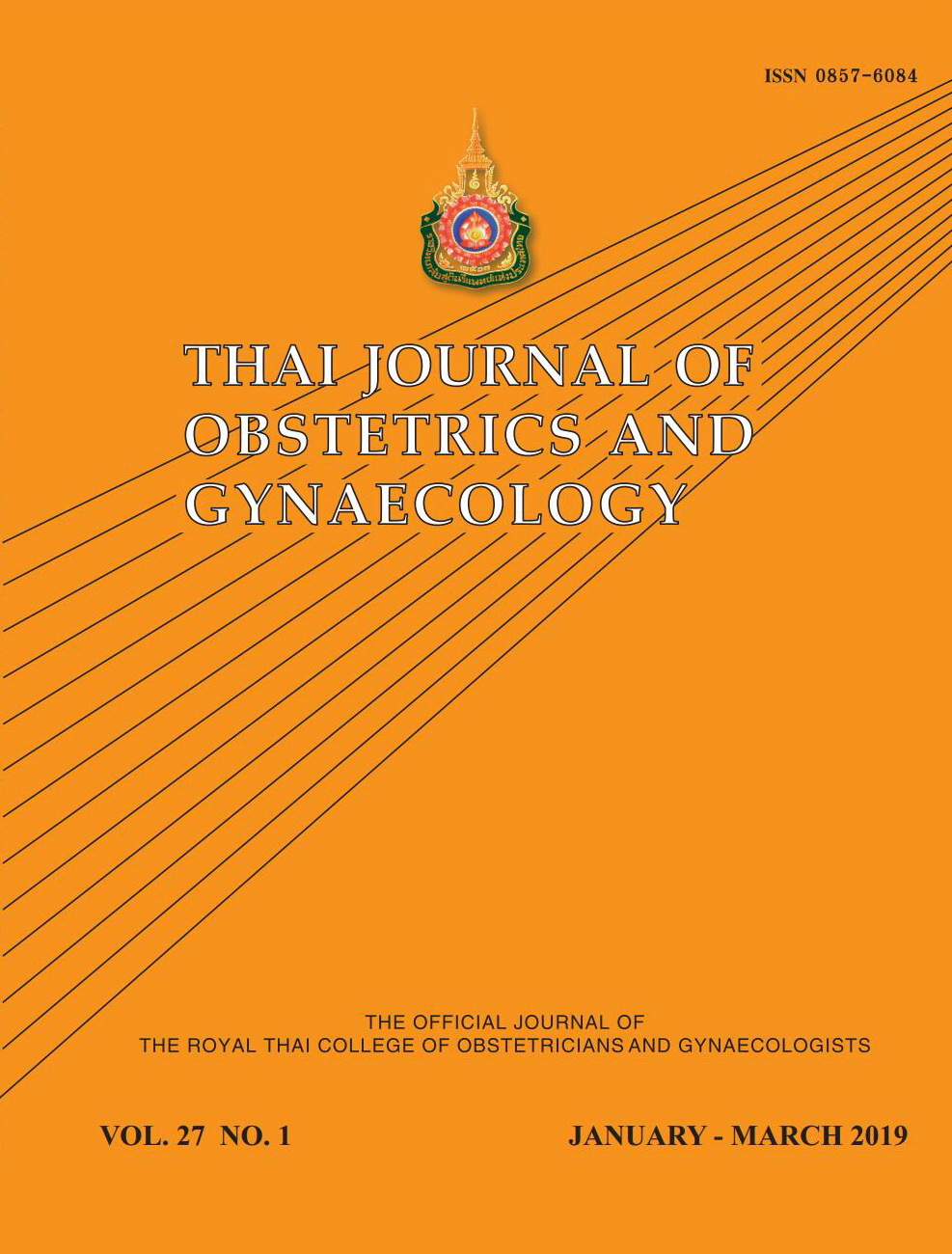Uterine Cooling during Cesarean Section to Reduce Intraoperative Blood Loss: A randomized controlled trial
Main Article Content
Abstract
Objectives: The aim was to compare uterine cooling and routine cesarean section as a means of reducing intraoperative blood loss.
Materials and Methods: Pregnant women who underwent cesarean section at Khon Kaen Hospital between May and June, 2017 were randomly assigned to one of two groups: the uterine cooling (UC) group (n= 80) or the control group (n= 80). In the UC group, the uterus was wrapped using a sterile cooling swab while in the control group a routine cesarean section (CS) was performed.
Results: In UC group, there was a statistically significant reduction in intra-operative blood loss compared with routine CS (252.8 ± 133.8 vs 472.9 ± 201.8 ml), mean difference 220 ml (95%CI 166.6-273.5). Uterotonic drugs use was significantly less in the UC group (1.3% vs 10%, p = 0.02). Length of hospital stay was significantly less in the UC group (3.0 ± 0.5 vs 3.2 ± 0.7 day; p = 0.01). There was no significant difference between the two groups in postpartum hemorrhage. There was no intraoperative hypothermia found.
Conclusion: Uterine cooling was associated with a reduction in intraoperative blood loss among pregnant women undergoing cesarean section.
Article Details
References
2. Ahmed MR, Sayed Ahmed WA, Madny EH, Arafa AM, Said MM. Efficacy of tranexamic acid in decreasing blood loss in elective cesarean section . J Matern Fetal Neonatal Med 2015;28:1014-8.
3. Cunningham FG, Leveno KJ, Bloom SL, Hauth JC, Rouse DJ, Spong CY. Williams Obstetrics. 24th ed. New York: McGraw-Hill 2014:780-8.
4. ACOG. Practice Bulletin No183: postpartum hemorrhage. Obstet Gynecol 2017;130:e168-86.
5. Kennedy BB, McMurtry Baird S. Collaborative strategies for management of obstetric hemorrhage. Crit Care Nurs Clin North Am 2017;29:315-30.
6. Baird EJ. Identification and management of obstetric hemorrhage. Anesthesiol Clin 2017;35:15-34.
7. Mitchell JL, Stecher J, Crowson J, Rich D. Uterine cooling during cesarean delivery to reduce blood loss and incidence of postpartum hemorrhage: a randomized controlled trial. Obstet Gynecol 2015;125:9s-10s.
8. Manrique Muñoz S, Munar Bauzà F, Francés González S, Suescun López MC, Montferrer Estruch N, Fernández López de Hierro C. Update on the use of uterotonic agents. Rev Esp Anestesiol Reanim 2012;59:91-7.
9. Gizzo S, Patrelli TS, Gangi SD, Carrozzini M, Saccardi C, Zambon A, et al. Which uterotonic is better to prevent the postpartum hemorrhage? Latest news in terms of clinical efficacy, side effects, and contraindications: a systematic review. Reprod Sci 2013;20:1011-9.
10. Sheldon WR, Blum J, Vogel JP, Souza JP, Gülmezoglu AM, Winikoff B. Postpartum haemorrhage management, risks, and maternal outcomes: findings from the World Health Organization Multicountry Survey on Maternal and Newborn Health. BJOG 2014;121:5-13.
11. Abdel-Aleem H, El-Nashar I. Management of severe postpartum hemorrhage with misoprostol. Int J Gynaecol Obstet 2001;72: 75–6.
12. Schmitz T, Tararbit K, Dupont C, Rudigoz RC, Bouvier-Colle MH, Deneux-Tharaux C. Prostaglandin E2 analogue sulprostone for treatment of atonic postpartum hemorrhage. Obstet Gynecol 2011;118:257-65
13. Lalonde A; Prevention and treatment of postpartum hemorrhage in low-resource settings. Int J Gynaecol Obstet 2012;117:108-18.
14. Rani PR, Begum J. Recent advances in the management of major postpartum haemorrhage. J Clin Diagn Res 2017;11:qe01-5.
15. Chassard D, Bouvet L. Administration of tranexamic acid to reduce maternal mortality related to postpartum haemorrhage: comments on the WOMAN trial. Int J Obstet Anesth 2018;33:89-90.
16. Shakur H, Roberts I, Edwards P, Elbourne D, Alfirevic Z, Ronsmans C. The effect of tranexamic acid on the risk of death and hysterectomy in women with post-partum haemorrhage: statistical analysis plan for the WOMAN trial. Trials 2016;17:249.
17. Faraoni D, Carlier C, Samama CM, Levy JH, Ducloy-Bouthors AS. Efficacy and safety of tranexamic acid administration for the prevention and/or the treatment of post-partum haemorrhage: a systematic review with meta-analysis. Ann Fr Anesth Reanim 2014;33:563-71.
18. Wray S, Jones K, Kupittayanant S, Li Y, Matthew A, Monir-Bishty E, et al. Calcium signaling and uterine contractility. J Soc Gynecol Investig 2003;10:252-64.
19. Wray S, Kupittayanant S, Shmigol T. Role of the sarcoplasmic reticulum in uterine smooth muscle. Novartis Found Symp 2002;246:6-18.
20. Sunano S. The effects of Ca antagonists, manganese and lanthanum on cooling-induced contracture of depolarized vas deferens. Jpn J Pharmacol 1984;34:51-6.

